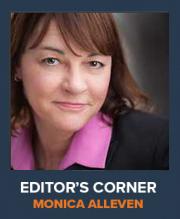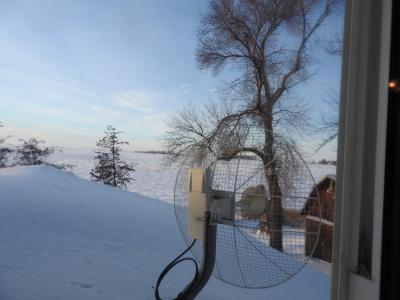
Where were you when the historic Arctic blast struck over the holidays?
I was in Minneapolis, about two hours north of my final destination, when the “once-in-a-generation” weather event happened. Some called it a “bomb cyclone.” Other reports referred to the Polar Vortex.
Whatever you call it, it was cold enough to turn boiling water into snow when you toss it in the air. I know, because we did that with my great nephew, who’s 5, and his dad. It was a lot of fun.
Not so fun was the subsequent and dicey road trip to my hometown in southern Minnesota. That’s where my relatives hosted me, sans internet. At first, it didn’t seem that outrageous that the internet was out. After all, a brutal winter storm kept everyone at home and closed major highways for a couple of days. Mother Nature wasn’t messing around.

The second day of the outage, we called LTD Broadband’s customer service and went through a series of steps to make sure the equipment in our home wasn’t the source of the problem. After a lot of unplugging cables and plugging them back in and turning the power off and on – and some mild hair pulling – we were told the problem was – brace for it – a larger network outage.
We waited – long enough to start considering alternatives and asking neighbors what they were experiencing.
Turns out, one neighbor pays for the highest level – 35 Mpbs – home office service offered by LTD and they weren’t affected by the outage. She also mentioned a great desire for fiber and writing letters in favor of grant money for alternatives, but that’s not an option right now. Another neighbor invested the $600 or so to get Starlink set up; he sounded happy with that decision despite not being a fan of Elon Musk.
Of course, I couldn’t help thinking about all the government funds being funneled to fiber and the cold shoulder for fixed wireless. Was this why fixed wireless is getting such a bad rap? I mean, service is usually OK, but this wasn’t a good look. And it was getting less acceptable with each passing day.
Conversely, my T-Mobile cell phone service worked fine, leading to those predictable questions about the feasibility of T-Mobile, Verizon or UScellular ever offering fixed wireless access (FWA) here. T-Mobile especially talks a big game about FWA in rural areas. But out here, in the tundra where there’s sometimes a mile separating most houses? I doubt it’s high on their priority list.
LTD’s fixed wireless internet was back in service by about day three or four.
What LTD says
When I returned home to seemingly balmy temperatures of the Pacific Northwest, I reached out to Corey Hauer, the CEO of LTD Broadband. His company has gone through some tumultuous times the past couple years, to put it mildly. LTD Broadband garnered the largest award of any company in the FCC’s Rural Digital Opportunity Fund (RDOF) reverse auction in 2020.
But last August, the FCC rejected the long-form RDOF applications of both LTD and Starlink, deeming they failed to demonstrate they could deliver the promised service. LTD detractors say it just doesn’t have the track record to deliver gigabit speeds to rural areas.
Asked about the outage at my relatives’ home in late December, Hauer initially said he figured it was due to battery power issues but upon further investigation, he said it was a failed radio on a tower. “That’s a pretty rare thing, but that is what happened there,” he said.
As for the bigger picture, that’s much harder to solve. Hauer said he’d like to settle with the FCC, but if it ends up going to court, he’s confident that LTD will prevail and the FCC is “going to look terrible.” The FCC hasn’t communicated with LTD at all since its application was rejected, he said.
“We look at this from the perspective of the rural resident,” he said, explaining that the reason they bid in RDOF was they thought they could bring fiber to these rural areas very quickly – not in years but this year. LTD is pursuing limited builds with its own money in some areas, but it’s mostly in a wait-and-see phase.
He’s still bullish on fixed wireless, particularly new gigabit-capable fixed wireless technologies, like a 60 GHz solution with 5 GHz backup from the likes of Ubiquiti. He also mentioned promising products from Cambium and Airspan Mimosa.
What’s the alternative?
LTD has access to more than 2,500 towers and it uses a variety of spectrum, including 5 GHz, 2.4 GHz, 900 MHz and the General Authorized Access (GAA) portion of the 3.5 GHz Citizen Broadband Radio Services (CBRS) band.
Fixed wireless might make more sense than fiber depending on how the economics pencil out in a given geography. But he reiterated that LTD figured out a way to build fiber at a much lower cost than a lot of other carriers.
“We’re actually willing to make a lot of investments to get just one customer or two customers hooked up,” he said. That’s an ethical position; in most areas, LTD is the dominant carrier, and if it wasn’t willing to make that extra investment, those homes wouldn’t get service – although they could always do something like Starlink. Hauer said satellite services along the lines of Starlink, Amazon’s Kuiper and others increasingly are going to be part of the solution, especially in extremely hard-to-reach areas. “I think it’s going to be a mix,” he said.
What’s his current thinking of FWA? “I think it’s great,” in particular the gigabit-capable fixed wireless. “It’s going to make sense in a lot of spots,” he said. But with fiber, at least the way LTD is doing it, it’s hard to make a business case to do fixed wireless in places where fiber costs about the same. If you can do either, fiber is probably the better solution, he said. He acknowledged that other companies, like Metronet, are economically building with fiber in some areas. But he stressed that when you’re using government funds, it makes sense to be as economical as possible.
“There’s not infinite money out there and I feel like a lot of these programs are pretending that there is,” he said. “I think of the rural resident first. How do we get fiber or good broadband to these rural residents as soon as possible? And I think the answer is and was RDOF. I think that was the mechanism that was the fastest to get broadband deployed in these areas.”
I asked about the area where we experienced the outage and if it’s realistic to think it will ever see fiber. He said if the FCC approves or settles in a way that gives LTD the ability to build out its RDOF obligations in Minnesota, that area will get fiber, and soon. There are poles there for aerial fiber, which can be used for deployments in summer or winter.
That’s good news for this rural area, if it does come to pass. In the meantime, fixed wireless is delivering the goods, albeit from one dominant provider. One can only wonder how much better it could be if more entities were supported, fixed wireless or other.